The World Wide Web has some excellent sites which cover the full history of audio recording. There are pictures and sound clips created on equipment used from the late 19th century and later. References to just a few of those sites are given below.
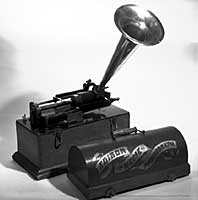
 The brief comments here focus specifically on
the
process of encoding information on different media, starting
with the cylinders of Thomas Edison's first phonograph. The
cylinders seen at the left were created acoustically, that is, a
stylus mounted on a vibrating diaphragm cut a groove in the
cylinder as it rotated. The
groove was deeper or
shallower depending on the
position of the vibrating
diaphragm. The diaphragm was set in vibration by sound waves sent
down and concentrated in a horn connected to it. A principal
difference between the recorders which cut the groove and the
phonograph which played them back is that there was a rotating
screw on the recorder (or cutting lathe) which governed the position of the cutting stylus. Other
than
that, the very earliest players looked a lot like the recorders which
created the acoustically cut groove. It was common practice for
soloists to run up to the recording horn so as to achieve a higher vibration (hence, volume) going
into
the stylus cutting the groove. An example of an early cylinder phonograph is shown at right.
The brief comments here focus specifically on
the
process of encoding information on different media, starting
with the cylinders of Thomas Edison's first phonograph. The
cylinders seen at the left were created acoustically, that is, a
stylus mounted on a vibrating diaphragm cut a groove in the
cylinder as it rotated. The
groove was deeper or
shallower depending on the
position of the vibrating
diaphragm. The diaphragm was set in vibration by sound waves sent
down and concentrated in a horn connected to it. A principal
difference between the recorders which cut the groove and the
phonograph which played them back is that there was a rotating
screw on the recorder (or cutting lathe) which governed the position of the cutting stylus. Other
than
that, the very earliest players looked a lot like the recorders which
created the acoustically cut groove. It was common practice for
soloists to run up to the recording horn so as to achieve a higher vibration (hence, volume) going
into
the stylus cutting the groove. An example of an early cylinder phonograph is shown at right.
Standard-size cylinders, which tended to be 4.25" long and 2.1875" in diameter, were 50
cents each
and typically played at 120 r.p.m. The early cylinders had two significant problems. The first
was
the
short duration of material recorded, usually around 2 minutes. This necessarily narrowed the field
of
what could be recorded. The second problem was that no mass method of duplicating cylinders
existed. Most often, performers had to repeat their performances when recording in order to
produce
a quantity of cylinders. This was not only time-consuming, but costly.
A process for mass-producing duplicate wax cylinders was put into effect in 1901. The
cylinders were
molded, rather than engraved by a stylus, and a harder wax was used. The process was referred to
as Gold Moulded, because of a gold vapor given off by gold electrodes used in the process.
Sub-masters were created from the gold master, and the cylinders were made from these molds.
From
a single mold, 120 to 150 cylinders could be produced every day. By mid-1904, the savings in
mass
duplication was reflected in the price for cylinders which had been lowered to 35 cents each.
Beveled
ends were made on the cylinders to accommodate titles. Columbia, one of Edison's chief
competitors,
abandoned the cylinder market in 1912. The original Edison cylinders were cut with vertical
"mountains and valleys," rather than lateral "wiggles" as pioneered by Victor. Supporters of the
vertical cut argued that it produced a superior sound. The popularity of cylinders peaked around
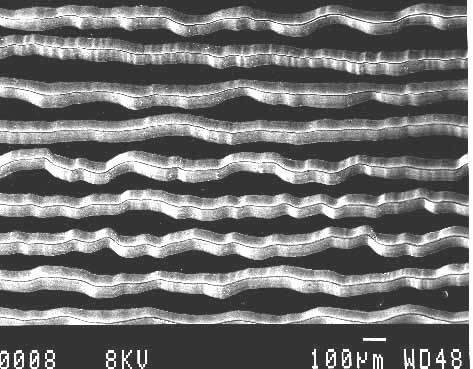 1905 largely because discs
were much easier to mass
1905 largely because discs
were much easier to mass
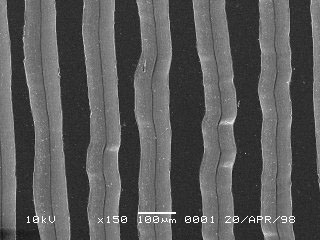 produce. Edison conceded to
this reality in 1913
when he announced the manufacture of the Edison
Disc Phonograph. The Edison Company did not
desert its faithful cylinder customers, however, and
continued to make cylinders until 1929. The Edison
Company had been fully devoted to cylinder
phonographs, but, concerned with discs' rising
popularity, Edison and his associates began to develop
their own disc player and discs in secret, but Edison
decided to retain the vertical vibrations (mountains and
valleys) on his discs. It was many years before the
lateral cut was accepted as superior largely because of the effect of lower average force acting in
the
direction of the vibration. Often the playback stylus (or needle, as it was called) had a higher
than
necessary mass behind it in the form of a kind of snail- or spiral-shaped expanding hollow metal
tube the air hole
of
which finally fed into the base of the horn. The force exerted on the cylinder by that spiral tube,
which could pivot so as to allow the stylus to rise and fall a little with the imperfect radius of the
rotating cylinder, was not carefully controlled in early phonographs and
ended up producing more wear on a vertically cut
groove. The laterally cut groove (with "wiggles") is
shown at left and right. The force in the direction of
playback (back and forth) was little more than the
springiness of the playback stylus in the direction of the
wiggle of the groove. Whatever force produced wear
at the bottom of the groove did not, at least in principal,
produce any vibration (even though the noise of such
playbacks testifies to there being all kinds of audio
"leakage" from rough groove bottoms). Treat yourself
to the sound of some early cylinder recordings:
produce. Edison conceded to
this reality in 1913
when he announced the manufacture of the Edison
Disc Phonograph. The Edison Company did not
desert its faithful cylinder customers, however, and
continued to make cylinders until 1929. The Edison
Company had been fully devoted to cylinder
phonographs, but, concerned with discs' rising
popularity, Edison and his associates began to develop
their own disc player and discs in secret, but Edison
decided to retain the vertical vibrations (mountains and
valleys) on his discs. It was many years before the
lateral cut was accepted as superior largely because of the effect of lower average force acting in
the
direction of the vibration. Often the playback stylus (or needle, as it was called) had a higher
than
necessary mass behind it in the form of a kind of snail- or spiral-shaped expanding hollow metal
tube the air hole
of
which finally fed into the base of the horn. The force exerted on the cylinder by that spiral tube,
which could pivot so as to allow the stylus to rise and fall a little with the imperfect radius of the
rotating cylinder, was not carefully controlled in early phonographs and
ended up producing more wear on a vertically cut
groove. The laterally cut groove (with "wiggles") is
shown at left and right. The force in the direction of
playback (back and forth) was little more than the
springiness of the playback stylus in the direction of the
wiggle of the groove. Whatever force produced wear
at the bottom of the groove did not, at least in principal,
produce any vibration (even though the noise of such
playbacks testifies to there being all kinds of audio
"leakage" from rough groove bottoms). Treat yourself
to the sound of some early cylinder recordings:
Click here to listen to some
cylinder recordings
and
Click here to listen to a
vertically cut disc.
 By the middle of the 1920s
discs were being recorded at a variety of speeds. Although 78 rpm was
said to be the industry standard, there was great variability in recording speeds for many years.
English Columbia routinely used 80 rpm into the 1920s. Other companies adopted speeds which
varied from 74 to 84 rpm.
By the middle of the 1920s
discs were being recorded at a variety of speeds. Although 78 rpm was
said to be the industry standard, there was great variability in recording speeds for many years.
English Columbia routinely used 80 rpm into the 1920s. Other companies adopted speeds which
varied from 74 to 84 rpm.
Around 1948 the vinyl record was born, that is the first
twelve inch "long play" (LP) microgroove records that played
at 33 1/3 rpm for up to 30 minutes per side, and seven inch
45 rpm singles and Extended Plays. The format was capable
of producing full frequency range. Claims of 20 Hz to 20,000 Hz were common, though the fall-
off in volume at either end seemed always either to be conveniently ignored or stated in the unit
decibels and in a manner which meant very little to the average audiophile. Still, recordings on a
vinyl base with the improved light weight pickup arms and styli offered a remarkable
improvement
in audio quality over the old 78s . These vinyl records were produced in a similar way
to
the Shellac 78s, that is, they were pressed from plates produced from a master. By the time LPs
appeared, recording on magnetic tape had enjoyed some considerable development and
electronic amplifiers produced consistently high sound quality throughout the recording process.
The
first vinyl disc offered only monaural sound (not stereo) which emanated from a laterally cut
groove of constant
width
as in the images above. Note in the right image above how close one groove comes at several
points to the next. A
particularly
loud passage sometimes produced sufficiently large "wiggles" to break over into an adjacent
groove,
so in order not to have to limit the loudness, a system of "dynamic separation" was developed to
detect the loudness on
the
master tape a distance ahead equal to one revolution of the disc so that the cutting stylus could be
moved further away from the previous groove before the volume increased. Even so,
bleed-across
was often evident. That is, a loud passage followed by a soft one could be heard one revolution
before it arrived because of slight compression of the previous groove by the stylus cutting the
next
adjacent groove. This was most commonly apparent in at the beginning of any disc the opening
passage of which was quite loud and could be heard at a much lower volume one revolution
before it arrived.
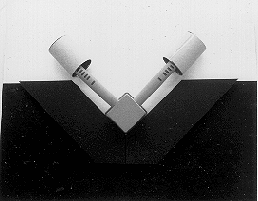
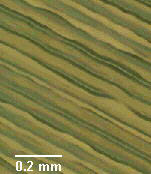 Monaural discs required information to be stored in a
lateral cut moving back and forth parallel to the surface of
the record. Stereo was made possible by cutting the
groove in a manner which "encoded" the left and right
channels in motion at right angles to each other but
diagonal to the surface of the disc. Both the cutting coils of the cutting lathe
and pickup coils of the stereo turntable or phonograph were arranged as shown in the figure at
the left. The signals going into the cutting coils (and then picked up by the playback coils)
corresponded to signals representing what would be heard by one's left and right ears. In
principle, stylus motion in one direction would produce no motion in the other because the two
were at right angles to each other. In practice there was always a little "cross-over" from one
channel to the other. Stereo sound was at first achieved with two microphones, often placed
close together and pointed at the performing group in a
manner meant to approximate one's sensory experience. The signals were picked up, amplified
and fed onto two tracks on a tape
recorder. Soon that primitive technique evolved into multi-track master tape recordings with
subsequent
changes made in an editing room to produce more pleasant effects on each channel. In any case,
a stereo disc ended up having to use both the lateral cut
pioneered by the Victor Company and the vertical cut first introduced by Edison, but the high
level
of noise which plagued the early shellac discs had been
largely eliminated by the smoother vinyl plastic of which the disc was made. Note that the
width of the grooves seem to change a bit in the image at
the right. There are wide and narrow regions. That is
caused by the V-shaped cutting stylus moving up and down
as well as back and forth. In particular, look at the place on
the lower middle right where the groove seems almost to
disappear. That particular point would be a prime candidate
for "skipping", a common phenomenon with discs in general
in which even the slightest jarring would cause the stylus to
jump out of the groove and to fall into another nearby groove.
Monaural discs required information to be stored in a
lateral cut moving back and forth parallel to the surface of
the record. Stereo was made possible by cutting the
groove in a manner which "encoded" the left and right
channels in motion at right angles to each other but
diagonal to the surface of the disc. Both the cutting coils of the cutting lathe
and pickup coils of the stereo turntable or phonograph were arranged as shown in the figure at
the left. The signals going into the cutting coils (and then picked up by the playback coils)
corresponded to signals representing what would be heard by one's left and right ears. In
principle, stylus motion in one direction would produce no motion in the other because the two
were at right angles to each other. In practice there was always a little "cross-over" from one
channel to the other. Stereo sound was at first achieved with two microphones, often placed
close together and pointed at the performing group in a
manner meant to approximate one's sensory experience. The signals were picked up, amplified
and fed onto two tracks on a tape
recorder. Soon that primitive technique evolved into multi-track master tape recordings with
subsequent
changes made in an editing room to produce more pleasant effects on each channel. In any case,
a stereo disc ended up having to use both the lateral cut
pioneered by the Victor Company and the vertical cut first introduced by Edison, but the high
level
of noise which plagued the early shellac discs had been
largely eliminated by the smoother vinyl plastic of which the disc was made. Note that the
width of the grooves seem to change a bit in the image at
the right. There are wide and narrow regions. That is
caused by the V-shaped cutting stylus moving up and down
as well as back and forth. In particular, look at the place on
the lower middle right where the groove seems almost to
disappear. That particular point would be a prime candidate
for "skipping", a common phenomenon with discs in general
in which even the slightest jarring would cause the stylus to
jump out of the groove and to fall into another nearby groove.
In 1983 digital recording technology became available for domestic use in the form of the Compact Disc (CD). Instead of recording the digital data on a magnetic medium, the stream of data is stored as tiny pulses on an aluminium disc coated in plastic. The data are then read using a laser

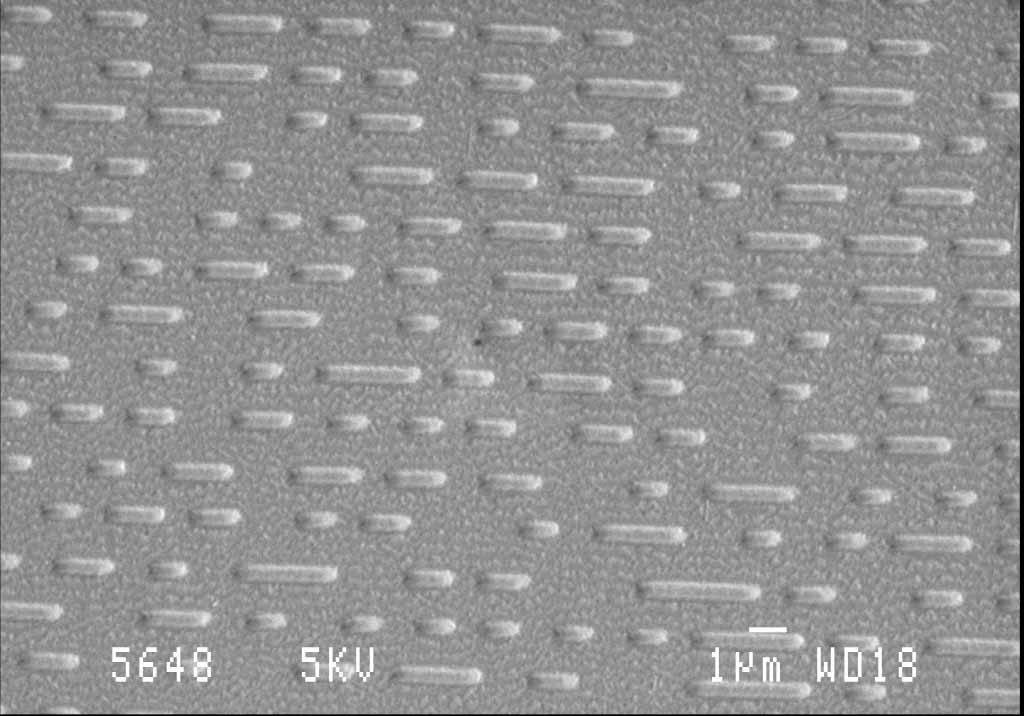 beam, thus eliminating physical wear on the discs. CD
technology has settled on a 16-bit audio "byte."
beam, thus eliminating physical wear on the discs. CD
technology has settled on a 16-bit audio "byte."
The bits in the byte are in the form of indentations in the disc
produced (initially at least)
by laser pulses. Note the
single commercially
produced melted pulse in a
disc surface at the left.
When linked together to
produce a series of audio
"bytes" the surface of the disc looks like the image at the right.
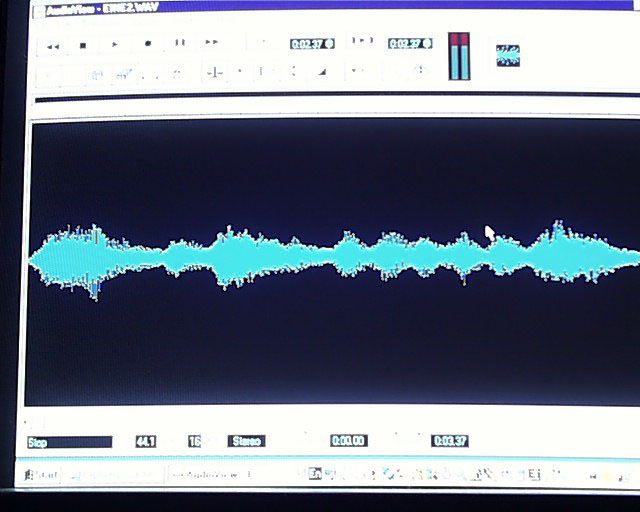
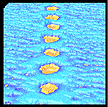 Recently, equipment to
produce one's own CDs has appeared on
the market at prices affordable by the average PC owner.
Several formats are available, one to produce audio CDs and
another to produce rewritable CDs offering a format which
appears no different in one's directory than that shown by a fixed
drive or floppy diskette. It is claimed that the pits produced by
home equipment
are not quite as
clean as
professional
masters. An
example of such a
claim is shown at the left.
Recently, equipment to
produce one's own CDs has appeared on
the market at prices affordable by the average PC owner.
Several formats are available, one to produce audio CDs and
another to produce rewritable CDs offering a format which
appears no different in one's directory than that shown by a fixed
drive or floppy diskette. It is claimed that the pits produced by
home equipment
are not quite as
clean as
professional
masters. An
example of such a
claim is shown at the left.
All that having been said, here is a link to a Real Media
file (converted from a digital CD) giving the first
second or two of the opening bars of Mozart's "Eine
Kleine Nachtmusik" (A little night music).
The sonogram or image of the vibrations of this music is shown at the right above. Be
cognizant that this "image" of the sound in the opening passage is of the original uncompressed
digital .WAV file created from a commercial CD of the piece, not
the
compressed .RM or Real Media file which you hear if you clicked on the link.
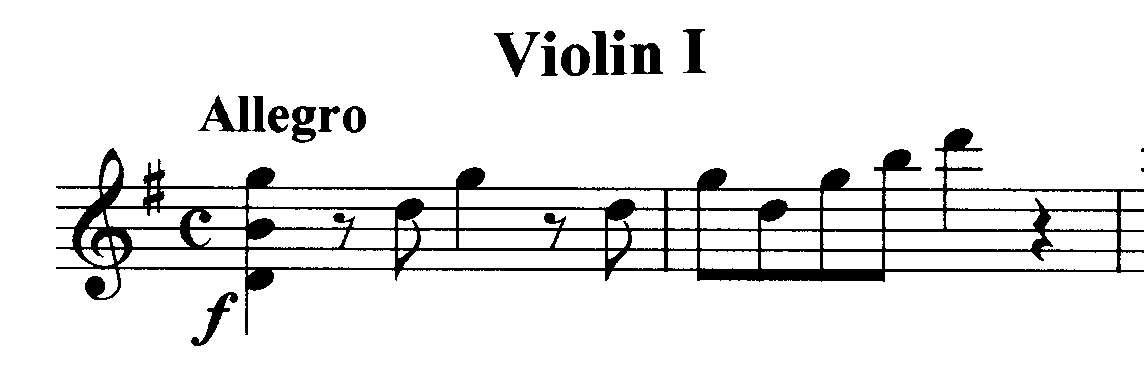 The first violin part is shown at the left to illustrate the coincidence between the size of the
"blips"
on the sonogram above and the note length in the music. The quarter notes are shown as large
blips and the eighths as small ones. The total time for a quarter note and an eighth rest is three
times that of an eighth note, as one would expect.
The first violin part is shown at the left to illustrate the coincidence between the size of the
"blips"
on the sonogram above and the note length in the music. The quarter notes are shown as large
blips and the eighths as small ones. The total time for a quarter note and an eighth rest is three
times that of an eighth note, as one would expect.
If a very tiny portion of this sonogram is copied and pasted to another .WAV file, it looks
like
the
image below. Each of the traces represents one of the stereo channels. The image has been
enlarged so that you can see the steps in the digital encoding. This small fragment is only 54
bytes
long for each channel. The standard sample rate for commercial CDs is 44,100 samples per
second per channel, so this fragment could be heard in a little over one one-thousandth of a
second. Not nearly enough time to start it, go into the kitchen for a cup of coffee and expect to
hear the rest of it on your return!
Each byte is a fixed sampled value. The playback machine must take sequential values and do a
digital-to-analog conversion so that an average smooth function results. Compressed audio files,
such as MP3 and RM (Real Media) files, are the result of "shortcuts" effected by the
compression
software.
The audio signal of an uncompressed WAV file is analyzed "on the fly" during the compression
process and the barest amount of data describing a particular signal shape finds itself replacing
the
actual shape in the compressed file. An example of such a shortcut would be to approximate the
rise one sees from the middle to the right side of the screen using two or three bytes and a code
indicating the time required to effect the rise. By so doing 3-4 bytes would be required instead of
the 26 or so one can count from the distinct dip to the right side of the screen. Such a shortcut
would offer a compression ratio of 26:4 or about 6:1. Much higher rates of compression are
possible if one is willing to make greater sacrifices in audio quality.
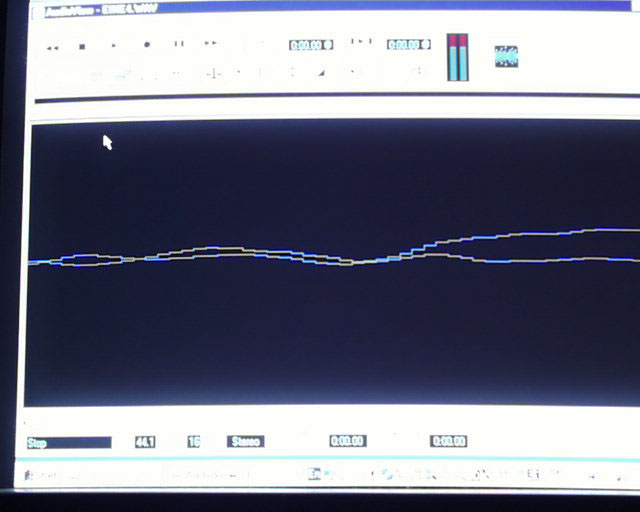
Thanks to all the people who
put out an enormous amount of work in preparing Web pages from
which much material was taken. The Web pages I used for this offering may be found at the
following sites:
(History of the Edison Cylinder
Phonograph)
(History of the Edison Disc
Phonograph)
and others which have been removed from the Web since I first created this page in 2007.